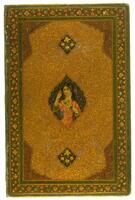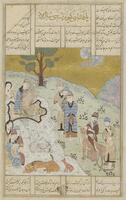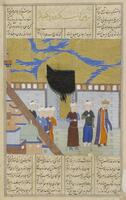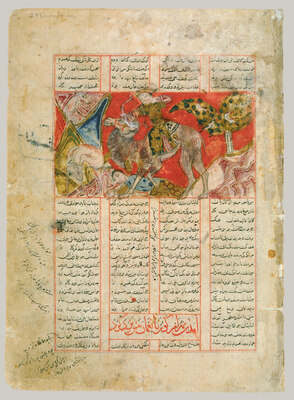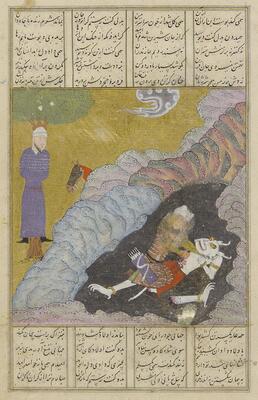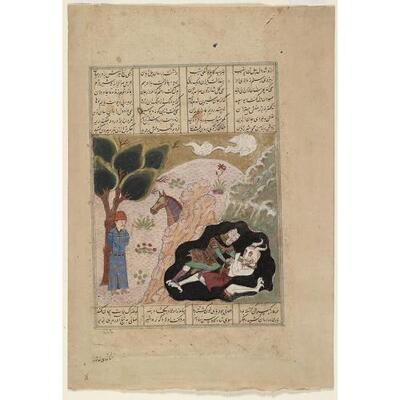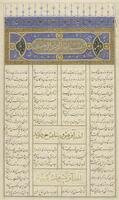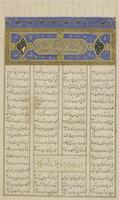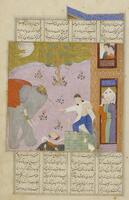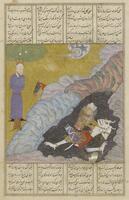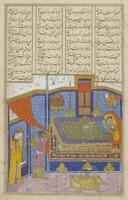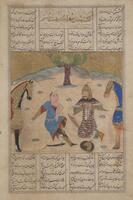Shahnama, the Persian Book of Kings
A Look at UMMA's Illuminated Manuscript
One of the world’s longest narrative poem, the Shahnama, or “Book of Kings,” provides a look into Persian culture both historical and legendary. In the tenth and eleventh centuries, during a period of Iranian history that was not a powerful or influential one, the Persian poet Ferdowsi began his quest to preserve his culture which had been threatened after the influence of the Turkish and Arabic peoples. It had been over 400 years since the fall of the Persian empire which resulted in the prominence of Islam over Zoroastrianism as well as the dominance of Arabic as the primary literary language. Ferdowsi wrote the Shahnama then to preserve the Persian language as well as restore a sense of prestige for Persia. Over time, the Shahnama was recognized for its importance and has subsequently survived to the present day, having influenced numerous other cultures with its powerful thematic elements and engrossing narratives.
Structure
The Shahnama has remained a monumental work for Iranians as well as many other cultures because of its inclusion of timeless stories. Within the epic are stories that explore the struggles and folly of man that result from power and greed. These struggles continue to have relevance; man against evil, himself, the supernatural, his own family, even fate. Ferdowsi’s writing was so powerful that he could find meaning with readers from the medieval period and readers in the present day.
The structure of the book begins with the Persian version of the origin of the world. This portion of the book is referred to by historians as the Age of Creation, as it is filled with mythical characters such as Gaiumart, “the legendary first shah who taught humans, ‘the arts of life.’” The stories of early kings are filled with battles against demons, the introduction of social classes, and the creation of crafts of both peace and war. From there begins the Age of Heroes. This period is filled with legendary kings who explore the deeper meanings of life. The stories within the Age of Heroes have underlying themes of rivalry and warfare that seems to plague the various legendary families for hundreds of years. In addition to the other portions of the Shahnama, the actions, faults, and qualities of the various kings provide moral lessons to the readers of the poem of how to rule justly and live virtuously. After the fantastic stories of legendary kings and mythical heroes, Ferdowsi begins to recount stories from the Historical Age. These stories contain real historical figures such as Darius III, Alexander the Great, otherwise known as Iskandar, and Bahram Gur. This period is interesting due to the adaptation of historical events to fit inside a Persian narrative. For example, Alexander the Great, historically a figure from the ancient Greek kingdom of Macedon, is adopted into the lineage of Persian kings. These alterations to history could be as simple as lack of proper records or could be attributed to Ferdowsi’s ultimate goals in writing the Shahnama. The Historical age concludes with the fall of the Sasanian empire to the conquest of Islam, but Ferdowsi chose to tell the story from the perspective of the Persians, one that could have easily been forgotten.
Illuminations
After Ferdowsi wrote the Shahnama, the earliest surviving copies of the poem were found over 200 years later. These copies are devoid of illuminations, or illustrations of the text that feature miniature paintings. Over time, there was a resurgence of interest in the text. This interest stems from the conquests that begin with the Mongols and the infamous, Genghis Khan. In the thirteenth and fourteenth century, there were numerous changes in power for the Persians. Each dynasty that ruled in the region had no ancestral ties to Persia and this was an obstacle for them. One method to alleviate the fact that many of these rulers had Turkish roots (many of the antagonists in the Shahnama were, in fact, Persian) was to commission copies of the Shahnama to show their appreciation of Persian culture. It was also during this period in which the different rulers, whether they were Mongols or Timurids, would include their own stories in the historical age of the Shahnama, creating a sense of legitimacy in their rule. In tandem with the increased patronage surrounding the Shahnama, there was also the introduction of book painting in the region. The creation of manuscripts was already an incredibly difficult and timely process as every part of the book was handmade--from the paper to the binding. Additionally, Islamic art manuscripts feature calligraphy of various languages based on region, which is another extremely arduous process that would take a single scribe their entire life to master. The process of creating miniature paintings surrounds a workshop of artists of varying talents where every aspect is done by hand, even the creation of pigments. In early illuminated manuscripts, the paintings were often small and subordinate to the text. (MET Bahrum Gur Hunting with Azada folio). Over time, tastes changed and book painting was developed. This development led to more elaborate and large-scale miniature paintings that dominate the folios. This can be seen in Ann Arbor’s copy of the Shahnama.
Kervorkian Shahnama
The copy held in UMMA’s collection has been dubbed the Kervorkian Shahnama, named after the previous collector who owned it. Through the research provided from Dr. Priscilla Soucek, she argues that the manuscript was created in the 1460’s in Baghdad for a Turkish prince, Pir Budaq. Her analysis of the work has been created by comparing different manuscripts contemporary to the Kervorkian copy from different regions. She attributes the manuscript to the fifteenth century due to both the number of illustrations as well as the size in proportion to the text. Illustrations became fewer in number throughout the whole manuscript, but larger in relation to the text, as well as more narrow—dominating the folio. In her research Soucek localizes the manuscript to the workshops of Shiraz in Iran during the fifteenth century as illustrations became more standardized across workshops in both style and subject matter, allowing for a close comparison of these visual aspects to other manuscripts from the region (See Images). While she argues that the manuscript was produced in Iran, the eclectic nature of the illustrations results in a blending of techniques and visual imagery from both Shiraz as well as Timurid styles. Soucek hypothesizes that the patron’s movements between Baghdad and Shiraz could have resulted in the mixture of styles as well as Persian manuscript production’s complicated visual tradition that was often influenced and changed by artists from different regions.
Cast of characters relevant to our manuscript:
1. From the Age of Creation
- Gaiumart: the legendary first shah who taught humans, "the arts of life"
- Ahriman: Gaiumart's opponent and the embodiment of evil
2. From the Age of Heroes
- Faridun: Shah of Iran for 500 years and the exemplar of a wise and virtuous ruler
- Salim: Eldest son of Faridun, he inherited the rule of "Rum" (generally, lands to the west of Persia). Characterized as one who flees from danger, and is "frantic, not brave."
- Tur: second son of Faridun, he inherited the rule of Turkestan and "Chin" (Central Asia). Characterized as one whose "courage is more ardent than a flame." His kingdom is known as Turan and its inhabitants Turanians
- Iraj: Youngest son of Faridun, he inherited the rule of the heartland of Persia (modern Iran, Iraq, and Arabia). Characterized as "one that can bide his time and yet be prompt," when faced with danger he responds prudently and with growing courage. Assassinated by his brothers.
- Kai Kaus: She of Iran for 150 years, the greedy and thoughtlessness Kai Kaus serves as the "negative model" of kingship. On the basis of a false accusation by his concubine, he subjected his son and heir Siyawush to trial by fire; and against the council of his advisers, he waged war repeatedly against neighboring kingdoms, with devastating results
- Siyawush: Son of Kai Kaus and a Turanian princess who was a granddaughter of Garsiwaz, brother of Afrasiyab, king of Turan. He was wrongly accused by one of Kai Kaus' wives of disloyalty and forced to undergo trial by fire. Exasperated at his father's willful behavior, Siyawush decamped to Afrasiyab's court, where he married Afrasiyab's daughter Farangis. Later, he was slandered by Garsiwaz and beheaded at Afrasiyab's command. Many years later his son Kai Khusrau would win revenge.
- Kai Khusrau: Son of Siyawush and Farangis, and thus descended from the royal houses of both Iran and Turan. In the course seeking revenge for his father's assassination, he slew his uncle Shida in personal combat and also had his maternal grandfather Afrasiyab and his great-great-grandfather Garsiwaz from his paternal side put to death. After a relatively brief reign as Shah, he abdicated his position and ascended to heaven. Khusrau represents the best of kingly virtues: filial piety, selfless patriotism, military valor, and faith in divine guidance.
- Luhrasp: Descendant of the ancient Shah Faridun, and appointed by Kai Khusrau as his successor to the throne
- Gushtap: Son of Luhrasp who demanded that his father yield the throne and, when chastised, went into exile in the West. He formed a martial alliance with Rum and returned a hero, and not long after Luhrasp did abdicate in his favor. Gushtasp ardently embraced Zoroastrianism and sent his son Asfandiyar to spread the new faith across Asia through military conquest.
- Asfandiyar: Son of Gushtasp. Falsely accused of plotting to depose his father. Imprisoned and later released to lead the Iranian armies against the Turanians. After his victories against supernatural forces and on the battlefield, he asked in earnest to be made shah. Gushtasp promised to do so if Asfandiyar could capture Rustam, knowing that the request was tantamount to his son's death sentence.
- Afrasiyab: Grandson of Tur, king of the Turanians, and mortal enemy of the Iranian shahs.
- Garsiwaz: Brother of Afrasiyab, grandfather of Kai Kaus' wife, and key instigator of Siyawush's murder
- Farangis: Daughter of Afrasiyab, and wife of Siyawush
- Shida: Son of Afrasiyab, he challenged Kai Khusrau to single combat and lost.
- Sam: Ruler of Sistan, a province in northeastern Iran, he is a courageous warrior, wise counselor, and loyal vassal to the Iranian royal house.
- Zal: Sam's albino son, who was abandoned at both and raised by a Simurgh, a mythical bird. Reconciled to his father as a young man.
- Rudaba: Daughter of Mihrab, the king of Kabul. Wife of Gal and mother of Rustam.
- Rustam: Son of Zal and Rudaba, and champion and loyal supporter of several generations of Iranian shahs. Described variously as "elephantine," "lion-like," and "radiant like the sun," Rustam is the ultimate embodiment of the ideal hero.
- Tahmina: Daughter of the king of Samangan (Samarkand), wife of Rustam and mother of Suhrab.
- Suhrab: Son of Rustam and Tahmina, but raised by Tahmina away from his father. He unknowingly challenged Rustam to combat and lost.
3. From the Historical Age
- Dara: Dara or Darb, known to the Greeks as Darius III, came to the throne as the thirteenth emperor of the Achemenid Persian Dynasty in 336 BCE. He was a ruler of the largest and wealthiest empire in the world--but an empire that politically and militarily was much weaker than it had been under Darius the Great (r. 521-486 BCE) or Xerxes I (485-465 BCE). He fled from the invading armies of Alexander the Great for almost a year, until he was murdered by his own men in the summer of 330 BCE.
- Sikander: Sikander is the Persian name for Alexander the Great (356-323 BCE), the Macedonian who united the Greeks and led them to a conquest of Asia Minor, Egypt, and the great Persian empire. Over time, the Persians adopted him into their lineage of kings, and Sikander is a major figure in the Shahnama.
- Ardshir: Ardshir overthrew the last of the Parthian overlords to establish the Sassanians, the second great Persian dynasty. He reigned from Ctesiphon on the Euphrates as the Sassanian Shah, from 224 to 241 CE. The Sassanians consciously sought to revive the glory of the Achemenids and re-conquered their territories west to Syria and east to the Indus River in modern Pakistan. The traditional enemies of the Sassanians were the Roman and Byzantine Empires, a state of affairs that profoundly shapes the worldview of the Shahnama.
-
Bahram Gur: "Bahram of the Wild Ass", Bahram V, who ruled as Sassanian Shah from 420 to 428 CE. As a historical personage, he lost a battle with the Byzantines but successfully repelled an invasion of the White Huns--both struggles part of a centuries-long conflict. His lasting legacy is in literature and legend, where he emerges as a fearless hunter (especially of the fur, the wild ass) and an irresistible lover.
Works Cited
Brend, Barbara, and Charles Melville. Epic of the Persian Kings: The Art of Ferdowsi’s Shahnameh. London/New York: I.B. Tauris, 2011.
Graybill, Maribeth. A Medieval Masterpiece from Baghdad: the Ann Arbor Shahnama. Ann Arbor: University of Michigan Museum of Art, 2004. Exhibition catalogue.
Soucek, Priscilla. "The Ann Arbor Shahnama and its Importance." In Persian Painting: From the Mongols to the Qajars, edited by Robert Hillenbrand, 267-279. London/New York: I.B. Tauris Publishers, 2001.
Created For
K-12 EducatorK-12 Student
Museum Visitor
UMMA Docent
UMMA Staff
University Faculty
University Student
Rate this Resource
AVG: 0 | Ratings: 0
& Author Notes
All Rights Reserved ()
Last Updated
May 23, 2018 2:37 p.m.Report
Reporting Policy
